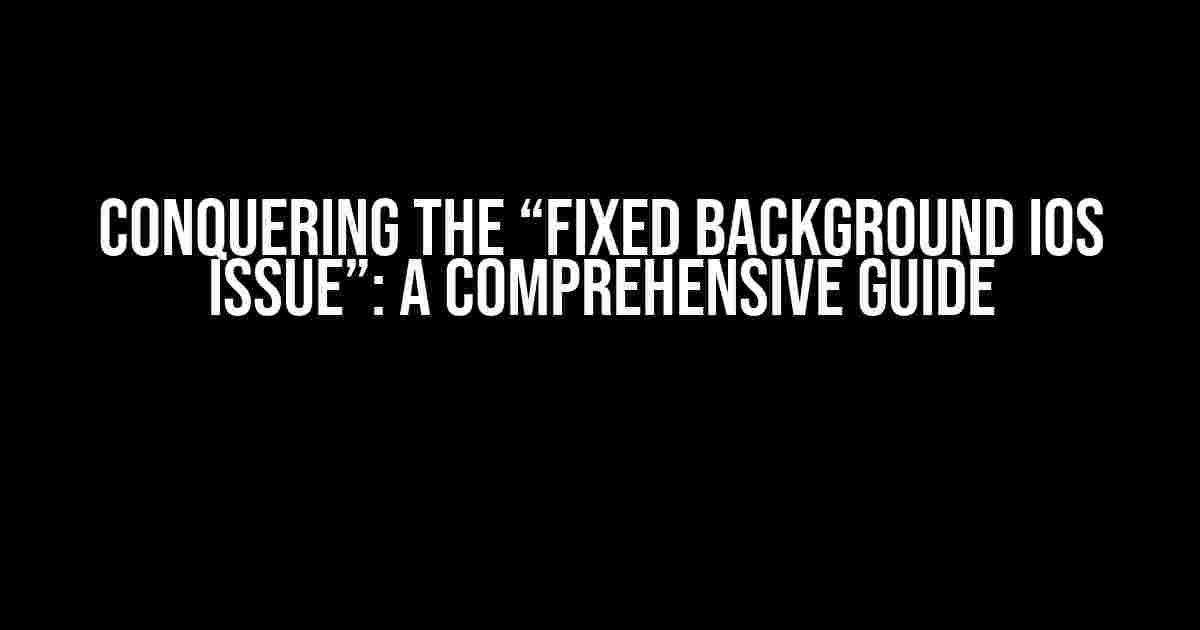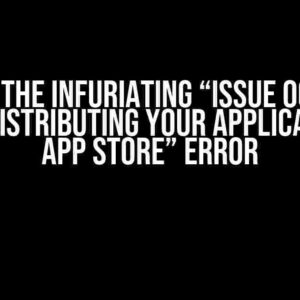Are you tired of dealing with the frustrating “Fixed Background IOS issue” that’s ruining the user experience on your website or mobile app? You’re not alone! Many developers and designers have struggled to overcome this annoying bug, but fear not, dear reader, for we’ve got you covered. In this article, we’ll delve into the world of iOS quirks and provide you with step-by-step instructions to fix this pesky problem once and for all.
What is the Fixed Background IOS Issue?
Before we dive into the solution, let’s quickly explain what this issue is all about. The Fixed Background IOS issue occurs when a website or mobile app with a fixed background image or video fails to render correctly on iOS devices. Instead of staying in place, the background moves along with the content, creating a jarring and unpleasant visual experience.
Why Does This Happen?
There are a few reasons why this issue crops up on iOS devices:
- iOS’s default behavior: iOS treats fixed backgrounds as “scrolling” elements, which means they’re intended to move with the content.
- WebKit’s rendering engine: Safari and other WebKit-based browsers on iOS use a different rendering engine than other browsers, which can lead to quirks like this one.
- overflow: scroll: When an element has `overflow: scroll`, iOS assumes it’s a scrolling container and applies the default behavior.
The Solution: A Step-by-Step Guide
Now that we’ve identified the problem, let’s move on to the solution. Don’t worry if you’re not a seasoned developer; we’ll break it down into simple, easy-to-follow steps.
Method 1: Adding `-webkit-transform: translateZ(0)`
This method involves adding a CSS transform property to the fixed background element. This trick tells iOS to treat the element as a 3D layer, which fixes the issue.
body {
background-image: url('background-image.jpg');
background-attachment: fixed;
-webkit-transform: translateZ(0); /* Add this line */
}Method 2: Using `-webkit-overflow-scrolling: touch`
In this method, we’ll add a different CSS property to the fixed background element. This property tells iOS to use momentum-based scrolling, which fixes the issue.
body {
background-image: url('background-image.jpg');
background-attachment: fixed;
-webkit-overflow-scrolling: touch; /* Add this line */
}Method 3: Setting `position: relative` and `overflow: hidden`
In this approach, we’ll change the CSS positioning and overflow properties of the fixed background element. This method works by creating a new stacking context and preventing the background from scrolling.
body {
background-image: url('background-image.jpg');
background-attachment: fixed;
position: relative; /* Add this line */
overflow: hidden; /* Add this line */
}Method 4: Using a Wrapper Element with `position: fixed`
In this method, we’ll create a wrapper element around the fixed background element and set its positioning to `fixed`. This approach ensures that the background stays in place.
<div class="fixed-background-wrapper">
<div class="fixed-background">
<!-- Your background image or video here -->
</div>
</div>
.fixed-background-wrapper {
position: fixed;
top: 0;
left: 0;
width: 100%;
height: 100%;
}
.fixed-background {
background-image: url('background-image.jpg');
background-attachment: fixed;
width: 100%;
height: 100%;
}Additional Tips and Tricks
While the above methods should fix the Fixed Background IOS issue, here are some additional tips to keep in mind:
- Use a JavaScript library: If you’re using a JavaScript library like jQuery, you can use its `.on()` method to listen for scroll events and adjust the background positioning accordingly.
- Apply the fix to a container element: Instead of applying the fix to the `body` element, try applying it to a container element that wraps your content. This can help prevent issues with other elements on the page.
- Test, test, test: Make sure to test your solution on various iOS devices and versions to ensure it’s working as expected.
Conclusion
And there you have it, folks! With these four methods and additional tips, you should be able to conquer the Fixed Background IOS issue and provide a seamless user experience on iOS devices. Remember to stay patient and persistent, as debugging can be a frustrating process. If you have any questions or need further assistance, feel free to ask in the comments below.
| Method | CSS Code |
|---|---|
| Method 1: `-webkit-transform: translateZ(0)` | -webkit-transform: translateZ(0) |
| Method 2: `-webkit-overflow-scrolling: touch` | -webkit-overflow-scrolling: touch |
| Method 3: `position: relative` and `overflow: hidden` | position: relative; overflow: hidden; |
| Method 4: Wrapper Element with `position: fixed` | position: fixed; top: 0; left: 0; width: 100%; height: 100%; |
Which method worked best for you? Share your experiences in the comments below!
Frequently Asked Questions
Got stuck with the pesky Fixed Background issue on your iOS device? Don’t worry, we’ve got you covered! Here are some frequently asked questions to help you troubleshoot and fix the problem:
What is the Fixed Background issue on iOS, and why does it happen?
The Fixed Background issue occurs when a website or web application sets the background-attachment property to “fixed” in its CSS, causing the background image to stay fixed and not scroll with the content. This can lead to a poor user experience, especially on smaller screens. It happens because iOS devices have a different handling of the background-attachment property compared to other browsers.
How do I identify if I’m experiencing the Fixed Background issue on my iOS device?
If you notice that the background image on a website or app is not scrolling with the content, and instead remains fixed, you’re likely experiencing the Fixed Background issue. Another way to identify the issue is to check the website’s or app’s CSS code, where you’ll find the background-attachment property set to “fixed”.
Is there a way to fix the Fixed Background issue on iOS without modifying the website’s or app’s code?
Yes, you can try using a third-party browser on your iOS device, such as Google Chrome or Mozilla Firefox, which might render the website or app correctly. Alternatively, you can try using a CSS override or a user stylesheet to modify the background-attachment property. However, these workarounds might not work for all websites or apps.
How can I fix the Fixed Background issue on my own website or app for iOS users?
To fix the issue, you can add a CSS media query that targets iOS devices and sets the background-attachment property to “scroll” or removes it altogether. You can also use a framework or library that provides a workaround for the issue. Additionally, consider using a responsive design that adapts to smaller screens and devices.
Will Apple fix the Fixed Background issue in future iOS updates?
While Apple has acknowledged the issue, there is no official word on when or if they will fix it in future iOS updates. However, with the growing demand for better web experiences on mobile devices, it’s possible that Apple might address the issue in the future.




